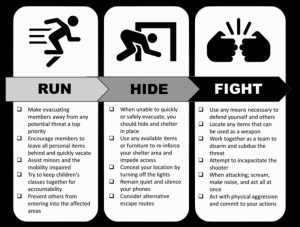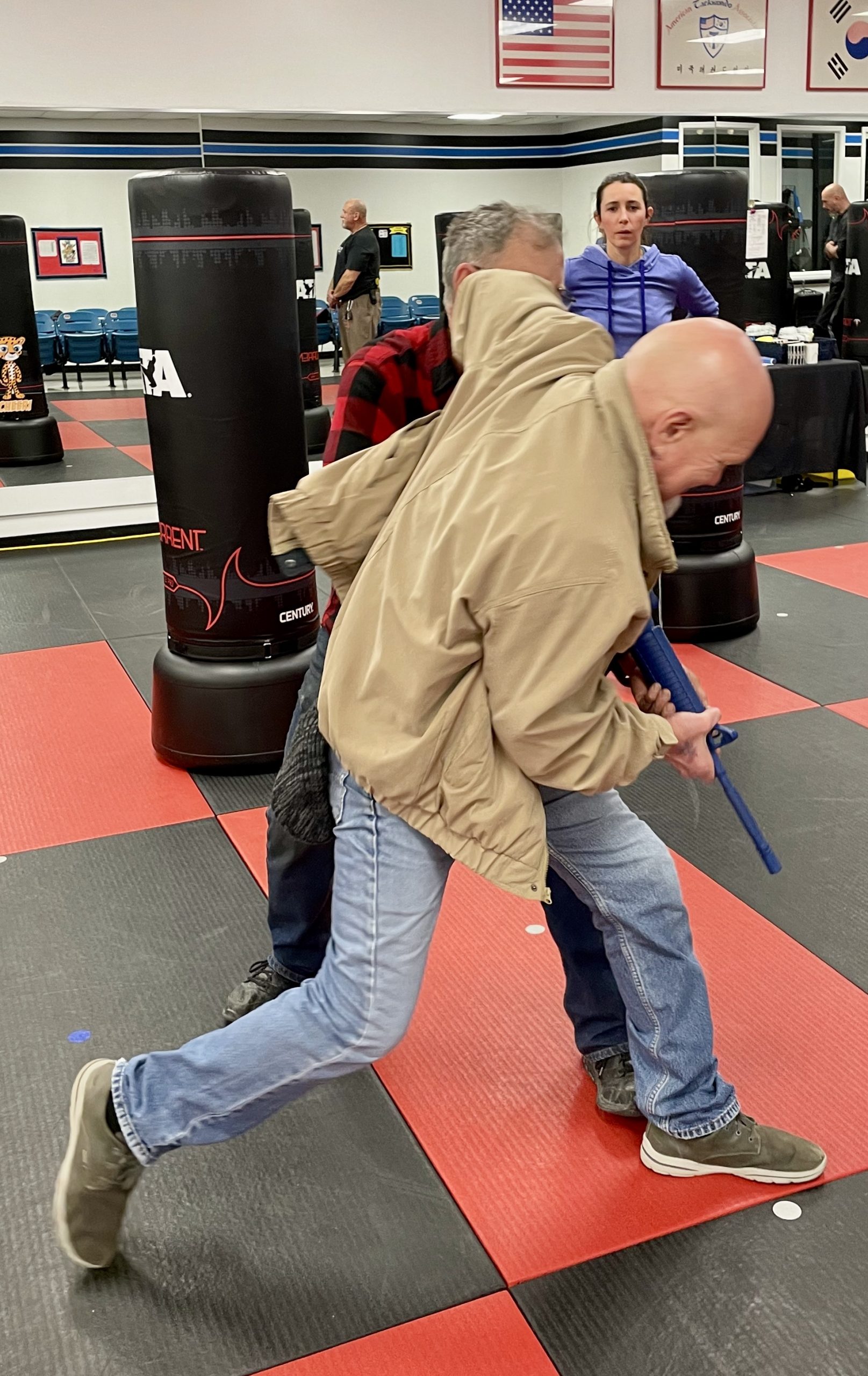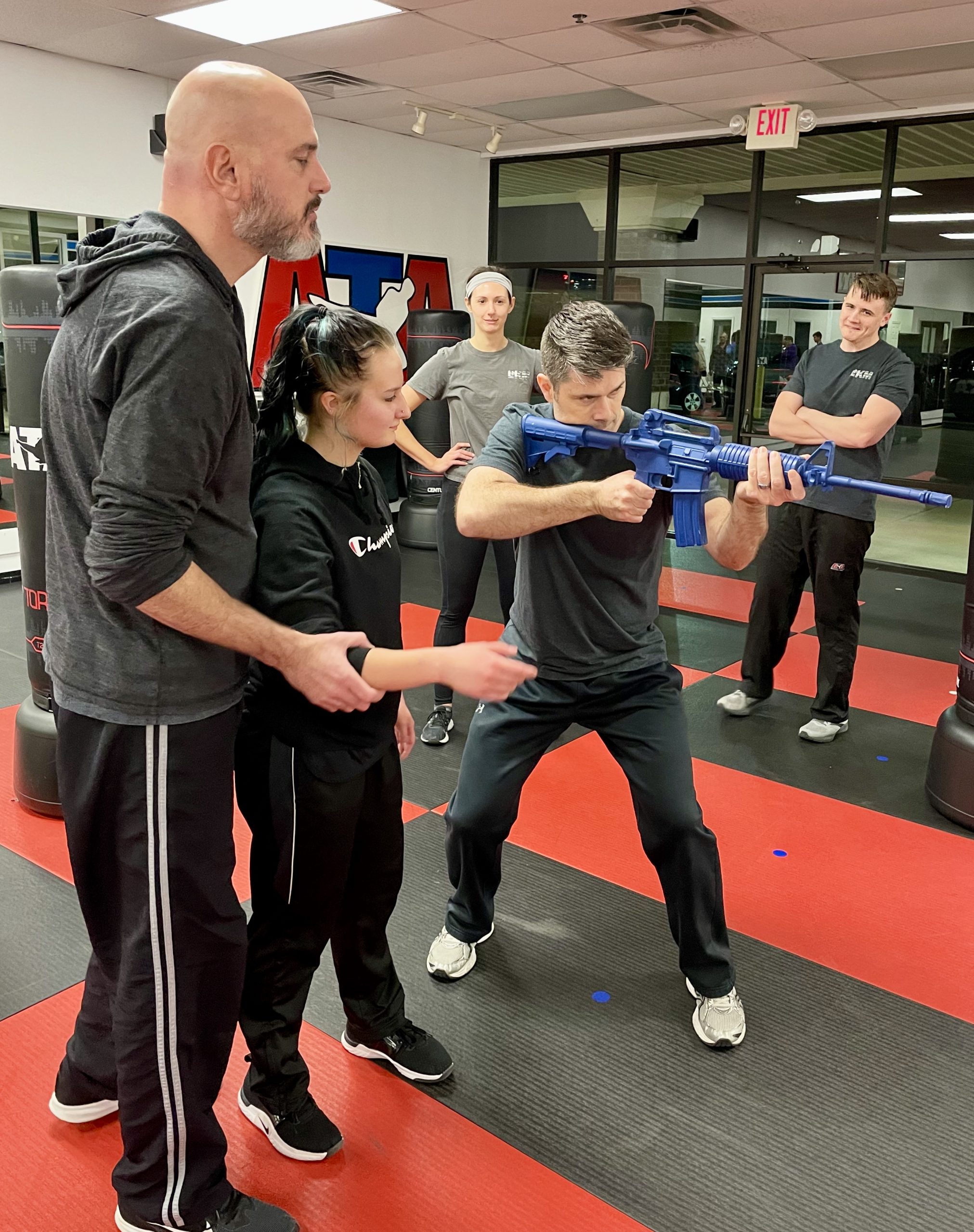Active Shooter Training
What Is An Active Shooter?
The FBI defines an active shooter as “an individual actively engaged in killing or attempting to kill people in a populated area”. They go on to say that, “Recent active shooter incidents have underscored the need for a coordinated response by law enforcement and others to save lives.” That is where we come in. It is our goal to partner with schools, workplaces, houses of worship and other venues to train individuals and teams how to react in the stressful environment of an Active Shooter. There is something you can do!
What Can You Do?
Our training will allow you to be able to save lives in the event of an active shooter. We will cover all options open to the defender such as improvised weapons when in a ‘No Carry’ zone or bringing your own firearm to bear. We would like to help you learn to become the ‘First Responder’ for your group. Some of the training we use involves some of the following information.
Run / Hide /Fight
In the event of an active shooter. The Department of Homeland Security advises that you should use the principles of Run, Hide, Fight. These principles have real value. However, Master Brown teaches that it is not always in this order. Depending on the situation you might decide to Fight first. For instance if you are in close proximity to a shooter and he has a weapons jam. It might be the safest thing to engage him now and not wait for him to clear a jam or to change magazines. Training at Leadership Martial Arts helps you to make decisions ahead of time and provides you with the training to act on those decisions decisively.

RUN
If there is an accessible escape path, attempt to evacuate the premises. Be sure to:
- Have an escape route and plan in mind
- Evacuate regardless of whether others agree to follow
- Leave your belongings behind
- Help others escape, if possible
- Prevent individuals from entering an area where the active shooter may be
- Keep your hands visible
- Follow the instructions of any police officers
- If your are a teacher try and keep your class together
- Prevent others from entering any affected areas
- Call 911 when you are safe
HIDE
If evacuation is not possible, find a place to hide where the active shooter is less likely to find you. Your hiding place should:
- Be out of the active shooter’s view
- Provide protection if shots are fired in your direction (i.e., an office with a closed and locked door)
- Lock the door
- Blockade the door with heavy furniture
- Turn off lights
If the active shooter is nearby:
When unable to quickly or safely evacuate, you should hide and shelter in place. You should also:
- Lock the door
- If you cannot lock the door, use any furniture to barricade if possible
- Silence your cell phone and/or pager
- Turn off lights
- Turn off any source of noise (i.e., radios, televisions)
- Hide behind large items (i.e., cabinets, desks)
- Remain quiet
- Consider alternative escape routes
If evacuation and hiding out are not possible:
- Remain calm
- Dial 911, if possible, to alert police to the active shooter’s location
- If you cannot speak, leave the line open and allow the dispatcher to listen
As a last resort, and only when your life is in imminent danger, attempt to disrupt and/or incapacitate the active shooter by:
- Use any means necessary to defend yourself and others
- Acting as aggressively as possible against him/her
- Yelling
- Committing to your actions
- Work together as a team to disarm and subdue the threat
- Organize people to use improvised weapons (fire extinguisher, stapler, heavy objects) to fight off the attacker, anything you can throw)
- When attacking; scream, act all at once
- Use your personal side arm (When Law Enforcement arrives: eject your magazine, lock your slide open on an empty chamber and place your weapon on the ground)
Indicators Of Possible Workplace Violence
Employees typically do not just “snap,” but display indicators of potentially violent behavior over time. If these behaviors are recognized, they can often be managed and treated. The Department of Homeland Security says that potentially violent behaviors by an employee may include one or more of the following (this list of behaviors is not comprehensive, nor is it intended as a mechanism for diagnosing violent tendencies):
- Increased use of alcohol and/or illegal drugs
- Unexplained increase in absenteeism; vague physical complaints
- Noticeable decrease in attention to appearance and hygiene
- Depression / withdrawal
- Resistance and overreaction to changes in policy and procedures
- Repeated violations of company policies
- Increased severe mood swings
- Noticeably unstable, emotional responses
- Explosive outbursts of anger or rage without provocation
- Suicidal; comments about “putting things in order”
- Behavior which is suspect of paranoia, (“everybody is against me”)
- Increasingly talks of problems at home
- Escalation of domestic problems into the workplace; talk of severe financial problems
- Talk of previous incidents of violence
- Empathy with individuals committing violence
- Increase in unsolicited comments about firearms, other dangerous weapons and violent crimes
How To Respond When Law Enforcement Arrives
- Remain calm, and comply with all commands
- Put down any items in your hands (i.e., bags, jackets)
- Immediately raise hands and spread fingers
- Keep hands visible at all times
- Avoid making quick movements toward officers such as holding on to them for safety
- Avoid pointing, screaming and/or yelling
- Do not stop to ask officers for help or direction when evacuating, just proceed in the direction from which officers are entering the premises
Church Safety / Levels Of Force
Churches are sometimes targeted by an active shooter for various reasons. Because of this Leadership Martial Arts & Krav Maga also trains and equips Churches to provide their own security. It is critical that your place of worship forms a safety team that is constantly working to prevent and prepare for the invasion of an armed intruder. Ideally, your security team should be filled with trained individuals such as, law enforcement officers, federal and state police, military personnel, veterans, firefighters, emergency workers, etc. Your congregation is filled with these qualified individuals who would be happy to assist in the security of their place of worship. Some of the reasons churches are targeted:
- Disgruntled church members
- Those involved in domestic disputes
- Gang members
- Mentally unstable individuals
- Terrorists
- Thieves
Levels Of Force
- Level 1- Safety Team Presence
- Level 2- Verbal Commands
- Level 3- Empty Hand control
- Level 4- Less Than Lethal Methods
- Level 5- Deadly Force
Level 1
Just the presence of a Safety Team in a church is a deterrent to anyone meaning harm or disruption. Many predators ‘recon’ churches before they act. They are looking for a ‘soft target. A “soft target” is a person, thing, or location that is easily accessible to the general public and relatively unprotected, making it vulnerable an active shooter or terrorist attack. The presence of the Safety Team makes the church a ‘hard target’. By contrast, a “hard target” is heavily defended or not accessible to the general public. The goal is always to de-esculate all situations. Often times this can be accomplished with being friendly and helpful. Taking notes during a conversation with a disgruntled person frequently is all it takes to satisfy someone who is frustrated.
Level 2
Verbal commands ought to be given with a firm and authoritative voice. The authoritative voice can be given in a conversational volume or can increase with volume when any resistance is given to a safety team member.
Level 3
Empty Hand techniques are used by a safety team members when a person becomes combative or disruptive during a sermon or presentation and they have to be escorted out. This is utilized when verbal commands have failed and waiting on law Enforcement is not an option (such as during a sermon with a congregation is present). Putting your hands on a person or grabbing a person to escort them out should be used with verbal commands such as “Quit resisting” or “Stop fighting”. This communicates with the combatant your intent. It will also serve to educate people around you that that is your goal is to de-esculate the situation.
Level 4
Less that Lethal techniques are things such as striking with your fists, knees or elbows. This is utilized when a combatant is actively striking or kick you or another team member. It is important to know that this is used when all other means have failed and yourself or another team member is a risk of injury. This force must cease when resistance is ended or when there is no more threat.
Level 5
Deadly force can be defined as force that is likely to cause serious bodily injury or death to another person. This force is necessary when protecting yourself or another from likely deadly force from a combatant. This force is utilized only as a matter or last resort to protect yourself or another from threats with things such as firearms or knives.
Training is necessary to gain the skills to perform each of these levels appropriately. If you would like to augment your skill sets, contact us at Leadership Martial Arts & Krav Maga
Michael Brown is a seventh degree black belt in Taekwondo. He has been serving his community in self defense training for over 30 years. Michael enjoys working with Military, law enforcement and civilians. He is also a certified instructor under both Krav Maga Worldwide and Warrior Krav Maga. Michael is a two time world champion in sparring and a former Captain in the United States Marine Corps. He is also a firearm safety expert. Michael trains individuals in both concealed and carry techniques and in handgun safety. He enjoys teaching alongside his wife Kimberly and son Michael. They have a goal to help you to become combat ready. Teaching you skills that will enable you to be the ‘First Responder’ for your family.
Leadership Martial Arts & Krav Maga serves the communities of: Fayetteville, Hope Mills, Spring Lake and Linden NC

